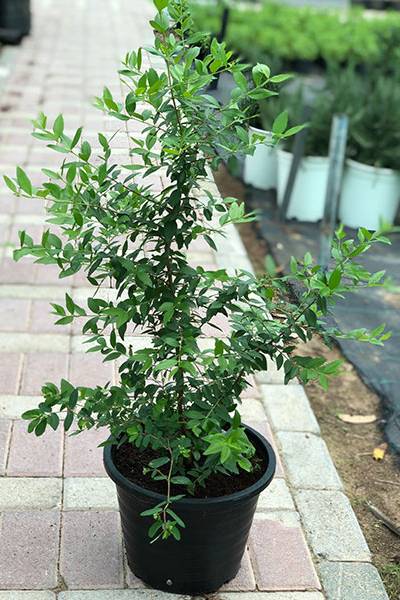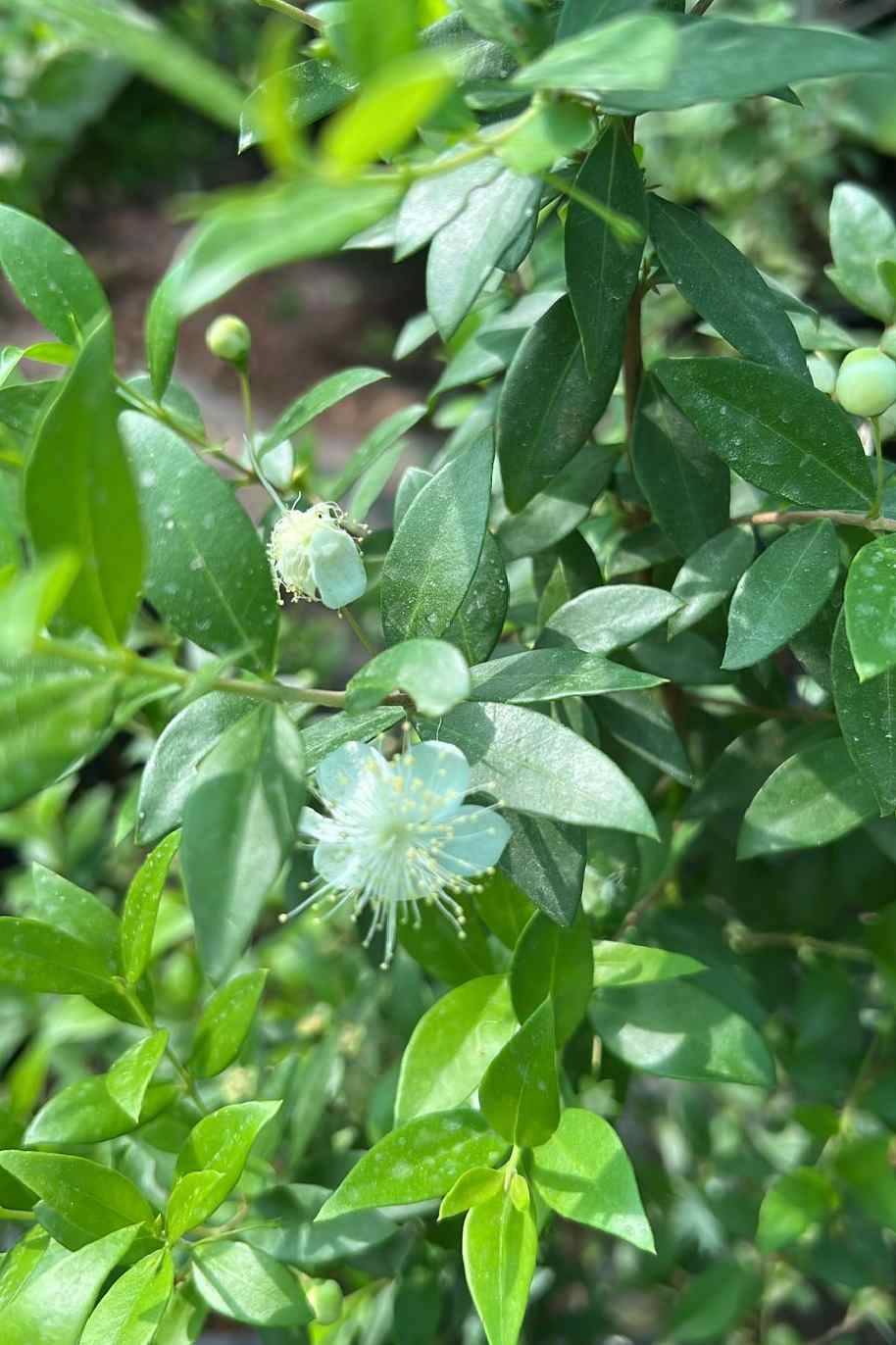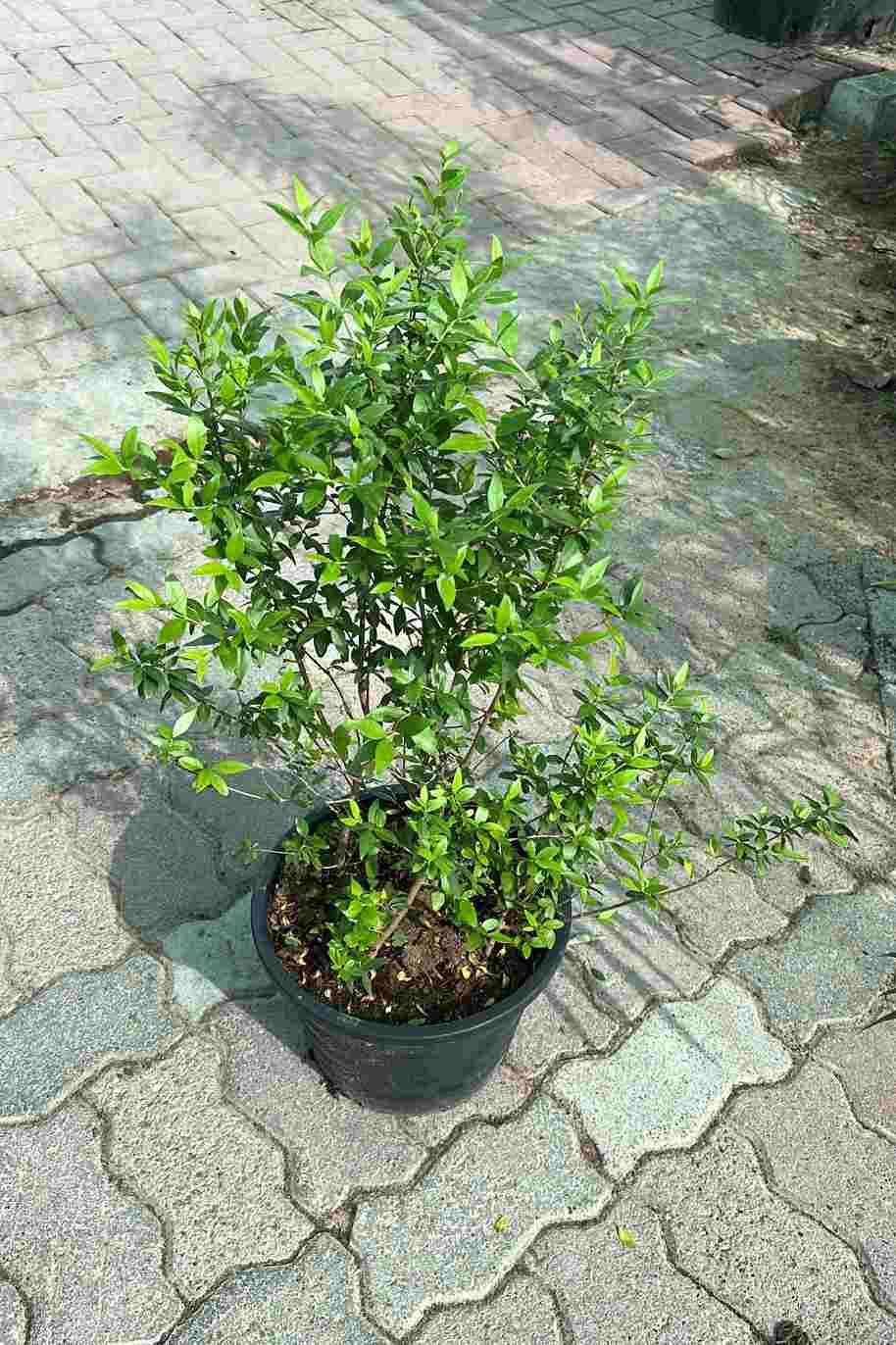Plant Bio
Myrtus communis, commonly known as Common Myrtle or True Myrtle, is an evergreen shrub or small tree prized for its aromatic foliage, attractive flowers, and ornamental berries. Belonging to the Myrtaceae family, Myrtus communis is native to the Mediterranean region and has been cultivated for centuries for its culinary, medicinal, and ornamental purposes. Here's a description:
Foliage: Common Myrtle features dense, glossy, ovate to lance-shaped leaves arranged alternately along the stems. The foliage emits a pleasant fragrance when crushed or brushed against, reminiscent of eucalyptus or camphor. The leaves are typically dark green in color and may have a slightly leathery texture.
Flowers: Myrtus communis produces small, star-shaped flowers that are white or creamy-white in color and have prominent stamens in the center. The flowers are solitary or clustered at the leaf axils and bloom profusely in late spring to early summer, attracting bees, butterflies, and other pollinators.
Berries: Following flowering, Common Myrtle develops round, fleshy berries that ripen to purplish-black or blue-black hues. The berries are edible, although they are often bitter or astringent when consumed raw. They can be used to make jams, jellies, syrups, or infused spirits, adding a unique flavor and aroma.
Growth Habit: Common Myrtle typically grows as a compact, multi-branched shrub or small tree with a dense, bushy habit. It can reach a height of 6 to 12 feet (1.8 to 3.7 meters) tall and spread of 4 to 8 feet (1.2 to 2.4 meters), although it can be pruned to maintain a smaller size or trained as a hedge or topiary.
Aroma: The foliage of Myrtus communis emits a distinctive, aromatic scent that is both refreshing and invigorating. The fragrance is often described as fresh, herbal, and slightly spicy, with hints of pine, citrus, and camphor. It is a popular choice for aromatic gardens, hedging, or container cultivation.
Care Guide for Myrtus Communis (Common Myrtle):
Light:
Plant Common Myrtle in a location that receives full sun to partial shade. While it can tolerate some shade, it thrives in full sunlight, which promotes lush foliage growth, abundant flowering, and berry production. Ensure adequate air circulation around the plant to prevent fungal diseases.
Temperature:
Common Myrtle prefers moderate to warm temperatures and is well-suited to Mediterranean climates. It can tolerate occasional frosts or brief periods of cold weather but may suffer damage if exposed to prolonged freezing temperatures. Protect young plants or tender growth during winter months.
Soil:
Grow Common Myrtle in well-draining, slightly acidic to neutral soil with good fertility. A loamy or sandy soil enriched with organic matter is ideal for promoting healthy root growth and overall plant vigor. Avoid heavy, waterlogged soils that can lead to root rot or other moisture-related issues.
Watering:
Water Common Myrtle regularly to keep the soil consistently moist but not waterlogged. Provide deep, thorough waterings, especially during hot, dry periods or when the plant is actively growing or flowering. Allow the top inch (2.5 centimeters) of soil to dry out between waterings to prevent overwatering.
Fertilization:
Feed Common Myrtle with a balanced, slow-release fertilizer formulated for shrubs or evergreens in spring, just before new growth begins. Alternatively, use a water-soluble fertilizer diluted to half-strength every 4 to 6 weeks during the growing season to provide essential nutrients for healthy growth and flowering.
Pruning:
Prune Common Myrtle as needed to maintain its desired size, shape, and density. Remove any dead, damaged, or diseased branches, as well as any crossing or overcrowded growth. Pruning can be done after flowering to encourage bushy growth and stimulate new flowering shoots for the following season.
Mulching:
Apply a layer of organic mulch, such as shredded bark, compost, or pine needles, around the base of Common Myrtle to conserve soil moisture, suppress weeds, and improve soil fertility. Keep the mulch several inches away from the stem to prevent stem rot or fungal diseases.
Pest and Disease Control:
Monitor Common Myrtle regularly for signs of common pests such as aphids, scale insects, or spider mites, as well as fungal diseases like powdery mildew or leaf spot. Treat any infestations or diseases promptly with insecticidal soap, neem oil, or fungicides labeled for ornamental plants.
Propagation:
Propagate Common Myrtle from semi-hardwood or hardwood cuttings taken from healthy, mature stems in late spring to early summer. Dip the cuttings in rooting hormone powder and plant them in well-draining potting mix or a propagation tray filled with perlite or vermiculite. Keep the cuttings warm and lightly moist until they develop roots.
Container Culture:
Grow Common Myrtle in containers or large pots filled with well-draining potting mix, especially in regions with cold winters or limited garden space. Choose a container with drainage holes to prevent waterlogging, and repot the plant into a slightly larger container every 2 to 3 years as needed.
With its aromatic foliage, attractive flowers, and ornamental berries, Myrtus communis (Common Myrtle) adds beauty, fragrance, and culinary interest to gardens, landscapes, and containers. Follow these care guidelines to ensure your Common Myrtle thrives and continues to delight with its vibrant foliage, fragrant blooms, and edible berries. Adjust care practices based on your specific growing conditions and the needs of the plant.










